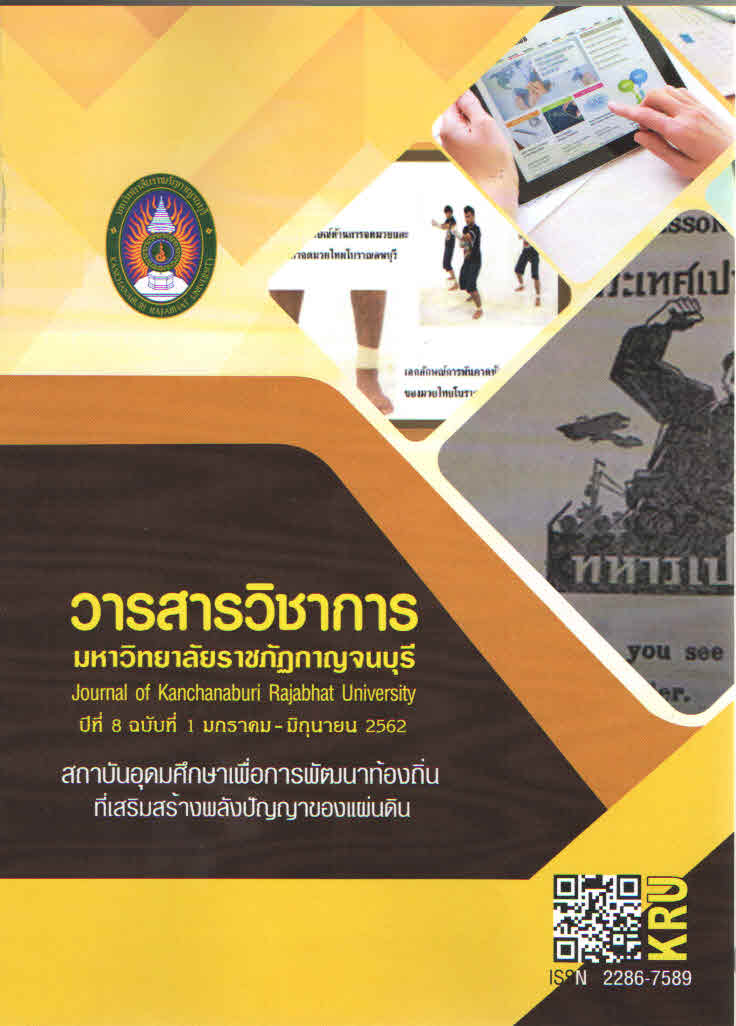การวิเคราะห์อุดมการณ์ในแบบเรียนภาษาอังกฤษสำหรับนักเรียนไทย: กรณีศึกษาแบบเรียนDirect Method Reader for Thai Students
Main Article Content
บทคัดย่อ
การวิจัยนี้มีวัตถุประสงค์เพื่อค้นหาและวิเคราะห์อุดมการณ์ของแบบเรียนภาษาอังกฤษเรื่อง Direct Method Reader for Thai Students ที่ใช้กับนักเรียนชาวไทยในช่วงทศวรรษ 1930 ถึง 1970 และวิเคราะห์ความเชื่อมโยงของอุดมการณ์กับปริบทประวัติศาสตร์ของไทย กระบวนการของการวิเคราะห์ใช้ทฤษฎีวาทกรรมวิเคราะห์เชิงวิพากษ์และการวิเคราะห์เนื้อหา กลุ่มตัวอย่างที่ใช้คือแบบเรียน Direct Method Reader for Thai Students จำนวนสามเล่ม การวิเคราะห์ข้อมูลประกอบด้วยขั้นตอนการอ่านเนื้อหา การวิเคราะห์ลักษณะทางภาษา และการวิเคราะห์อุดมการณ์โดยเชื่อมโยงกับปริบท ผลการวิจัยพบว่าอุดมการณ์สำคัญของแบบเรียนภาษาอังกฤษดังกล่าวมีสองประเภท คือ อุดมการณ์ชาตินิยมและอุดมการณ์คุณธรรมและระเบียบวินัย อุดมการณ์ชาตินิยมปลูกฝังความรักชาติให้นักเรียน อุดมการณ์คุณธรรมและระเบียบวินัยปลูกฝังให้นักเรียนเคารพผู้ใหญ่และเข้าใจหน้าที่ของตน การวิจัยนี้ช่วยให้ผู้สอนตระหนักถึงความไม่เป็นกลางในแบบเรียนและกระตุ้นให้ผู้สอนมีความคิดเชิงวิพากษ์ต่อเนื้อหาในแบบเรียนมากขึ้น กล่าวคือ สามารถวิเคราะห์มุมมองของผู้เขียนแบบเรียนได้
Article Details
เอกสารอ้างอิง
Arsairach, S. (2007). The Analysis and Evaluation of English Textbooks for Prathomsuksa. Master’s thesis, Silpakorn University.
Baker, C. & Phongpaichit, P. (2005). A History of Thailand. Cambridge: Cambridge University Press.
Blommaert, J. (2005). Discourse: A Critical Introduction. Cambridge: Cambridge University Press.
Camase, G. (2009). The Ideological Construction of a Second Reality: A Critical Analysis of a Romanian EFL Textbook. Master’s thesis, The University of Toronto.
Chetsurakul, N. (1993). The Analysis of Communicative Activities in English Textbooks for Students in Grade 8. Master’s thesis, Kasetsart University.
Connors, M. K. (2005). Ministering Culture: Hegemony and the Politics of Culture and Identity in Thailand. Critical Asian Studies, 37(4), 523-551.
Fairclough, N. (1989/2001). Language and Power (2nd ed.). Harlow: Pearson.
Fairclough, N. (2003). Analysing Discourse: Textual Analysis for Social Research. London and New York: Routledge.
Harwood, N. (Ed.) (2010). English Language Teaching Materials: Theory and Practice. Cambridge: Cambridge University Press.
Janks, H. (2014). Doing Critical Literacy: Texts and Activities for Students and Teachers. New York: Routledge.
Jumsai, M., M. L. (1939). Direct Method Reader for Thai Students Book 1. Bangkok: Aksornit.
Jumsai, M., M. L. (1940). Direct Method Reader for Thai Students Book 2. Bangkok: Aksornit.
Jumsai, M., M. L. (1961). Direct Method Reader for Thai Students Book 3. Bangkok: Kurusapha.
Kanjanasthiti, S. (2001). Asia: A Study on Social Studies Textbooks for Secondary Education. In K. La-ongsri (Ed.), Laos and Thailand: What do We Learn? An Analysis on Social Studies Textbooks. Bangkok: Five Area Studies Project.
Meesupsang, P. (2009). An Analysis of the English Textbook, Smart Choice 2, Student Book. Master’s thesis, Thammasat University.
Ministry of Education. (1976). A History of Thai Education. Bangkok: Ministry of Education.
Pennycook, A. (1995). English in the World/The World in English. In J. Tollefson (Ed.), Power and Inequality in Language Education. Cambridge: Cambridge University Press.
Reynolds, E. B. (2004). Phibun Songkhram and Thai Nationalism in the Fascist Era. European Journal of East Asian Studies, 3(1), 99-134.
Reynolds, C. J. (1991). Introduction: National Identity and Its Defenders. In C. J. Reynolds (Ed.), National Identity and its Defenders, Thailand, 1939-1989. Monash papers on Southeast Asia No. 25. Clayton: Centre of Southeast Asian Studies.
Saisin, A. (2003). Content Analysis of the Textbook Used in EG221 of Thammasat University. Master’s thesis, Thammasat University.
Salami, A. & Ghajarieh, A. (2015). Culture and Gender Representation in Iranian School Textbooks. Sexuality and Culture, 20, 69-84.
Sattayanurak, S. (2014). Nationalism and the Political Movement of Thai Middle Class. In A. Sattayanurak (Ed.), History of Thai Nation and Society: Family, Community, Commoner Life, Memory, and Ethnic Identity. Chiang Mai: Chiang Mai University Press.
Van Dijk, T. A. (2001). Critical Discourse Analysis. In D. Schiffrin, D. Tannen & H. E. Hamiltion (Eds.), The Handbook of Discourse Analysis. Malden: Blackwell.
Van Leeuwen, T. (2008). Discourse and Practice: New Tools for Critical Discourse Analysis. Oxford: Oxford University Press.
Wisaphrom, S. (2016). Ordinary Citizens after the 1932 Revolution. Bangkok: Matichon.
Wodak, R. & Meyer, M. (2009). Critical Discourse Analysis: History, Agenda, Theory and Methodology. In R. Wodak & M. Meyer (Eds.), Methods of Critical Discourse Analysis (2nd ed.). London: Sage.
Wyatt, D. K. (1982). Thailand: A Short History. Chiang Mai: Silkworm Books.


